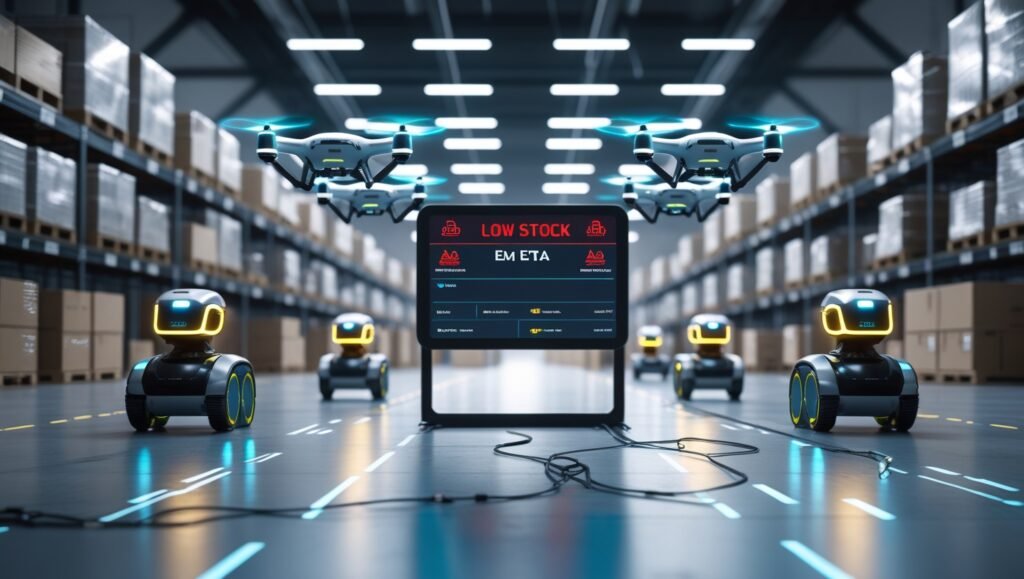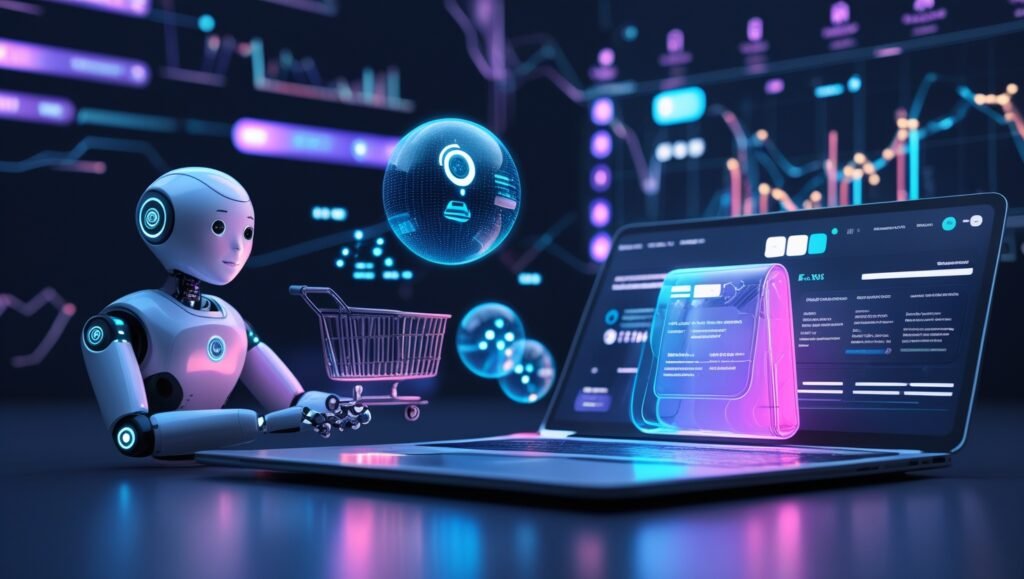The application of AI in e-commerce has transformed heretofore set standards in the online marketplace. Businesses are now utilizing AI technology to offer customers personalized shopping experiences as well as efficient delivery services. This guide will have in-depth look at how AI in e-commerce is changing the industry for both businesses and customers and question why this growing trend ought to be leveraged and paid attention to dodge loss of sales, loyalty, and market presence.
Let’s focus on the most pertinent changes brought into e-commerce by AI.
Customized Shopping Experiences: How is AI Innovating in E-Commerce

AI in ecommerce completely shifts the shopping paradigm from simple tailor made offers. Algorithms now optimize marketing efforts to include a user’s behavior, purchase history, and social media activity. Machine learning tools forecast what shoppers want, even before they log into a shopping portal. This is precisely why Amazon enjoyed 35% of revenue owing to their feature “Customers who bought this also bought”.
AI in e-commerce is transforming retail shopping into curated experiences. Let’s examine, how:
- Behavioral Analysis Virtual Shopping: AI measures clicks per minute, dwell time, and overall user engagement to make accurate predictions
Example: Algorithms, like those of Netflix, suggest items that users might be interested in, subsequently increasing average order value by over 15%.
- Dynamic Segmentation with Machine Learning: Classifying consumers by demographic intelligence combined with purchase history and total time spent on a website.
Stat: 80% of internet shoppers claim they would prefer purchasing from a brand that offers tailor-made experiences (Epsilon).
- Real Time Adjustments and Recommender Systems in AI: Amending suggestions based on a consumer’s behavior throughout a browsing session and predicting segments.
Case Study: AI stylists for Stitch Fix generated a 25% reduction in returns due to tailored picks made.
What distinguishes personalization from the competition is the ability to request AI support with ease.
AI-Powered Chatbots: Always-On Support Service Wizzes

AI in E-commerce is making radical changes in customer service:
- Immediate Interaction: Chatbots can address frequently asked questions instantaneously, saving time by 90%.
Use Case: H&M’s chatbot poses some style questions to help shoppers build their ideal outfits.
- Support in Multiple Languages: AI is able to translate conversations to over 100 languages and removes global communication barriers.
- Post Purchase Suggestions: Bots offer additional purchases that go hand in hand with the initial offer. Statistic: 34% of customers have expressed they prefer interacting with chatbots for trivial matters (Drift).
- Understanding Frustration: Artificial intelligence powered revelation of Natural Language Processing recognizes anger within the text and have the issue dealt with by a person.
In as much as businesses leverage customers interactions with chatbots, in the background AI serves its purposes by efficiently managing stocks.
E-commerce Inventory Optimization Through AI

Retail inventory mismanagement is responsible for an estimated $1.1 trillion loss yearly. Keeping in mind the importance of AI in e-commerce, it can predict upcoming demand surges, automate stock replenishment, and reduce excess inventory. Walmart, for example, uses AI to manage inventory in 4,700 locations, resulting in 15% waste reduction. Machine learning models look at weather patterns along with holidays and other trends to optimize shelf stocking.
AI in e-commerce simplifies curious stock inventories and issues as:
- Demand Forecasting: Requires the use of modern-day algorithms which study historical data, seasonality and other patterns.
Zara is a perfect example of a company that uses AI to replenish their best-selling garments in under 48 hours, thus managing to cut excess inventory by 30%.
- Automated Reordering: Whenever predetermined stock levels are hit, AI reorders stock automatically by placing purchase orders.
- Supplier Risk Assessment: Machine learning analyzes how dependable a supplier is and how much they are likely to delay delivery.
- Waste Reduction: Sales are prioritized for perishable products like groceries to prevent them being unsold and expiring. Statistic: Retailers employing AI to manage inventory have slashed spending by 35% (McKinsey).
The seamless pairing of stock optimization with AI’s magical pricing ensures maximum profit throughput.
Dynamic Pricing: AI’s Game Changer for Profit Margins

E-commerce business AI systems automate and facilitate price changes in accordance with demand, competition, and customer activity. Uber’s surge pricing and Amazon’s hourly price changes are case studies. AI tools like RepricerExpress enable sellers to compete while keeping profits intact. During Black Friday, for example, AI can increase the price of best-selling items while steeply discounting underperformers.
Here’s how AI can crack the e-commerce pricing challenge:
- Competitor Tracking: Scrapes rival sites for prices every hour.
Example: Amazon changes prices 2.5 million times daily using AI.
- Demand-Based Pricing: Higher prices during peak traffic periods (e.g., holidays).
- Personalized Discounts: Unique deals based on loyalty level of the user. Stat: Dynamic pricing boosts profits by 10% (MIT).
- Markdown Optimization: AI determines optimal time to discount old stock.
Sales are brought by smart pricing, trust, and secure transactions.
Fraud Detection: AI in E-Commerce as a Security Shield

Losses due to online payment fraud are estimated to be around $20 billion a year. AI is an expert against fraud in e-commerce as it recognizes transaction patterns, blocks suspicious activity, and flags anomalies in real time. AI systems like PayPal stop fraudulent transactions with 99.5% accuracy, and machine learning models adapt to newer fraud tactics over time, improving faster than older systems.
AI in e-commerce has made a mark on fraud detection and prevention:
- Anomaly Detection: Flags suspicious purchase behavior such as unusually high purchases from new accounts.
- Behavioral Biometrics: Analyzes typing patterns, mouse movements, and log-in speed.
- Card Testing Prevention: Blocks bots who try to test stolen card numbers to confirm them.
- Chargeback Prediction: Predicts high risk orders that merchants may want to ship, warning them before they ship.
Businesses face less payment fraud thanks to AI which Juniper Research shows estimates a 40% decrease in losses related to card payments.
While AI enhances security, visual search helps enhance discovery.
Visual Search: The Intersection of AI in E-Commerce and Innovation

AI has made it possible for users to search for products using images through Pinterest Lens and Google Lens. This has revolutionized visual searches in e-commerce. Visual search engines use shapes, colors, and patterns of images to retrieve relevant results. According to Forrester, sites employing visual searches have a 30% increase in conversion rates. IKEA is one of many brands that enable customers to use AR technology to “place” furniture in their homes.
The following examples illustrate how AI in e-commerce can transform images into profits:
- Pattern Recognition: Matches colors, textures and shapes to catalog items. Example Pinterest Lens is responsible for 85% of fashion related searches.
- Augmented Reality (AR) allows users to virtually “try on” products. An example is Warby Parker’s glasses.
- AI tagging allows social media posts, such as those on Instagram, to be made more interactive. According to Gartner, sites using visual search have 2x higher conversion rates.
AI has shopped down humanity’s greatest virtue – magnifying the importance of invention entwined with efficient marketing strategizing.
MARKETING CAMPAIGNS AND STRATEGY TARGETING THROUGH AI: DEEP FOCUS

The introduction of AI in e-commerce is revolutionizing marketing as it incorporates audience segmentation, anticipated campaign effectiveness, and advertisement expenditure automation. HubSpot and Mailchimp utilize AI for A/B testing email subject lines, determining optimal email dispatch times, and personalizing email content. Netflix’s AI-powered recommendation engine reportedly helps the company save around $1 billion annually in customer retention.
AI in e-commerce marketing has reached new peaks:
- Predictive Analytics: Forecasts campaign achievement likelihood prior to campaign initiation.
Example Sephora’s AI-email marketing campaigns achieve open rates that are thrice the norm.
- Ad Optimization: Most profitable viewers are targeted with automatic bids to advertise.
- Content Generation: Jasper.ai and other tools are able to autocomplete product description within seconds.
Stat: Salesforce states AI fueled marketing has increased ROI by thirty percent.
- Churn Prediction: Enables companies to identify customers that require retention strategies.
Although marketing excels, AI powered logistics are still required for effortless fulfillment.
The Heart of AI in E-Commerce: Supply Chain Optimization

AI in e-commerce integrates supply chains, from route planning to going “green.” DHL leverages AI to foresee shipping obstacles, and Watson from IBM reduces fu*el consumption by 10%. Demand forecasting also helps brands implement sustainability by reducing packaging waste.
AI in e-commerce enhances logistics efficiency:
- Route Planning: AI-assisted route planning lowers delivery time by 25% (ex. UPS’S ORION system).
- Warehouse Robotics: Faster than human workers by 500%, robots can now pick and pack orders.
- Sustainability: Emission reduction through transport mode selection and load optimization.
Stat: Supply chain costs with AI drop by 15% (Deloitte).
- Crisis Prevention: Anticipates port strikes or natural disasters that may cause disruptions.
In spite of the advantages of AI, there are impediments to using it.
Challenges of Implementing AI in E-Commerce

Adoption of AI technology is slow due to high implementation costs, skill gaps, and data privacy issues. GDPR compliance along with biased algorithm issues are still problems. Nonetheless, ethical AI frameworks and cloud-based tools, such as Shopify’s Kit, are addressing these issues.
Roadblocks for AI in e-commerce include:
- Data privacy: The use of data must be non-restrictive if GDPR/CCPA compliances need to be met.
- High costs: SMEs cannot afford to integrate AI at $50K to $200K.
- Bias risks: Biased data results in recommendations which are not appealing to users.
Example: Amazon had to get rid of an AI-driven recruiting tool that gave preference to males.
Still, the future holds hope for greater breakthroughs in AI technology.
The Coming Developments of AI in Ecommerce: The Unknown Ahead

AI will dominate the future of e-commerce along with voice commerce, augmented reality, virtual reality, hyper-personalization, and AI-created content. 95 percent of customer interactions are expected to be controlled through AI by 20303. ChatGPT produced content for product descriptions and shopping in the Metaverse are coming soon.
AI is bound to take the forefront in e-commerce with:
- Voice shopping: 55% of households will be utilizing voice commerce by 2025 with purchasing made easy with “Alexa, reorder toothpaste” (OC&C).
- NFT markets: Sale of virtual items with the capability of video try-ons in metaverse stores.
- AI hyper-personalization: AI uses biometrics like stress levels to predict needs.
- AI-Generated Content: Videos and advertisements are produced automatically at the time of viewing.
Final Thoughts
The use of AI in e-commerce is a monumental shift in business practices, optimizing productivity, tailoring services, and adding a layer of protection. Those companies that implement AI today will reap the rewards of market dominance in the future. You can get started with some simple steps such as introducing chatbots or dynamic pricing models and increase your investment with the profits. Retail will, without a doubt, and with great satisfaction, be guided by AI in the future as it will be intelligent and adaptive.






